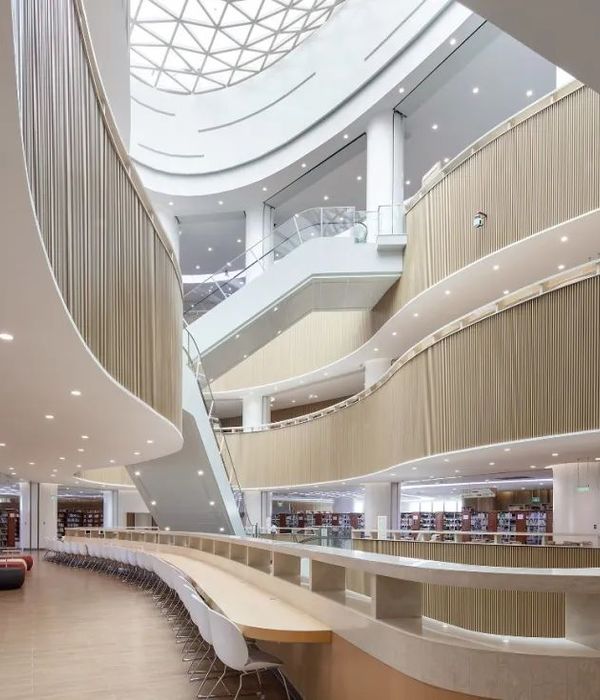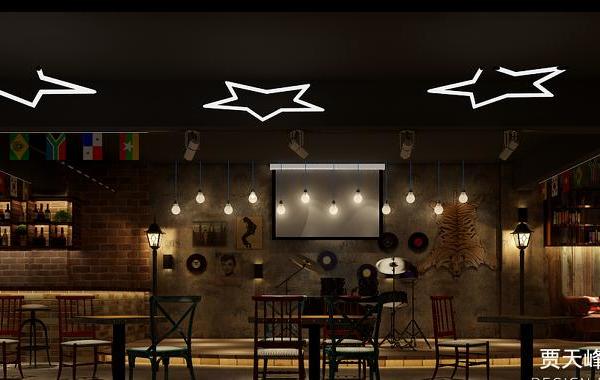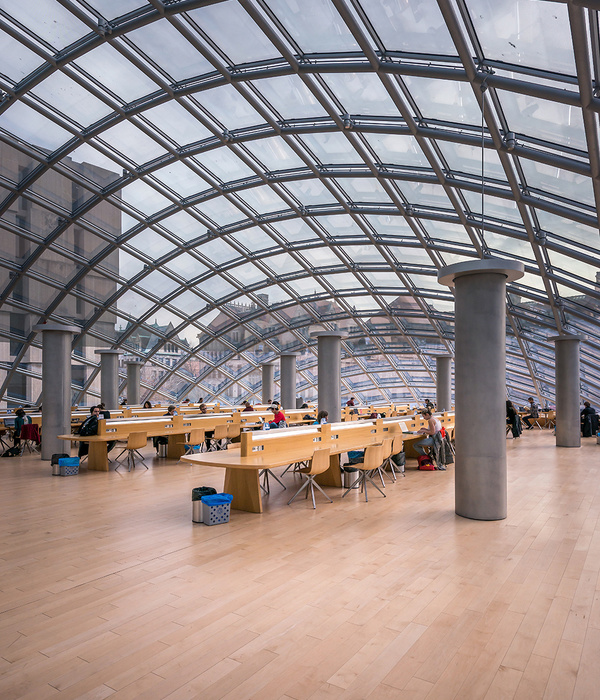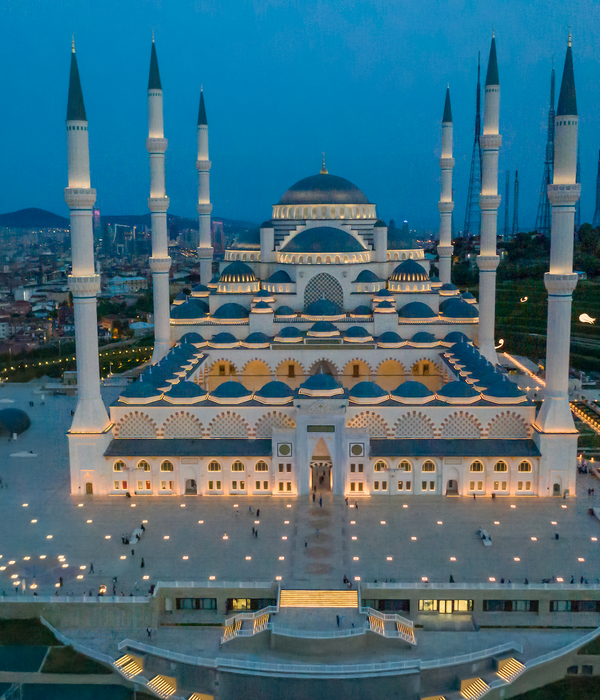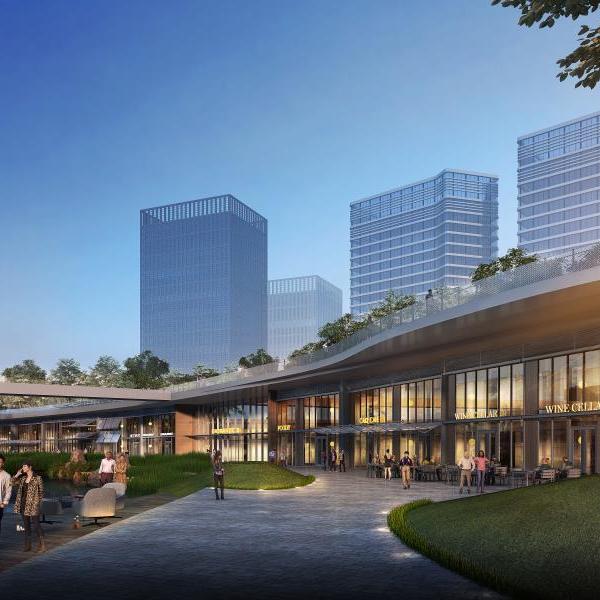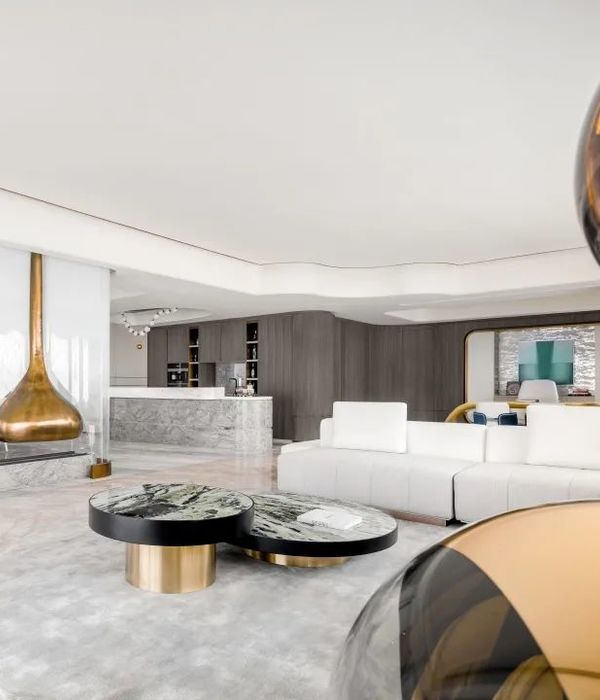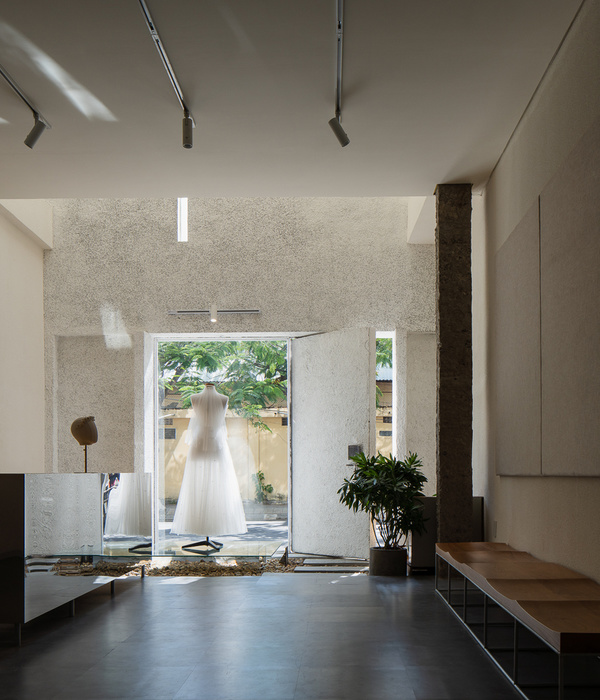A new wooden volume in the interior of the barn presents itself in the north facade and forms the entrance.. Image © Stijn Poelstra
谷仓内部的一个新的木卷出现在北面,形成了入口。图像(Stijn Poelstra)
架构师提供的文本描述。重置建筑将历史庄园的谷仓改造成博物馆。该项目涉及当前农村变化的主题,这一主题不再主要用于农业。在这个变化的背景下,这个项目的意图源于保存,分享过去的一个美丽的位置。这个适应性重用项目的架构不会以怀旧或主题的方式对历史做出反应,它使用的是一种更加上下文敏感的方法。内部已经改变到一个旧的和新的合并,但仍然是,没有层次,视觉存在的水平。因此,新的环境唤起了一种与自然风景特征有关的不言而喻的存在。
Text description provided by the architects. Reset Architecture transforms a barn at a historical estate into a museum. This project addresses a current theme of the changing countryside that is no longer mainly used for agriculture. Within this context of change the intention of this project originated from preservation; sharing the past of a beautiful location. The architecture of this adaptive reuse project does not react to history in a nostalgic or thematic way, it uses a more context sensitive approach. The interior has changed to a level in which the old and new merge but still are, without hierarchy, visually present. As a result the new setting evokes a self-evident presence that relates to the characteristics of the natural scenery.
The barn is insulated with flax in timber framed walls and roof and finished with clay plaster and . poplar from the estate.. Image © Stijn Poelstra
谷仓是用亚麻绝缘的木材框架墙和屋顶,并完成粘土灰泥和。庄园里的杨树.。图像(Stijn Poelstra)
博物馆罗马哈尔德藏有考古文物。哈尔德是罗马时代生产陶器和金属制品的著名聚居地。在考古遗址附近,该博物馆设在Haanwijk庄园。这座17世纪的庄园位于荷兰埃因霍温和赫托根博什之间的多梅勒河上一个美丽的自然区域。一个由树木、树林和田野组成的系统提供了一种令人惊讶的宁静的乡村感觉,坐落在离城市环境不远的地方。新博物馆强调了遗址的社会价值和历史意义。这是进一步大规模计划的开始,目的是对自然保护区进行修缮,并由业主修缮地产上的上市建筑。自然协会(自然协会)。
The Museum Roman Halder houses archaeological artifacts. Halder was a notable settlement where pottery and metal objects where produced during Roman times. Nearby the archaeological site, the museum is set up at the Haanwijk estate. The 17th century estate is located in a beautiful nature area at the river Dommel, located in-between Eindhoven and ’s-Hertogenbosch in the Netherlands. A system of well-perceived tree lanes, woods and fields provide a surprisingly quiet countryside feel, situated not far away from urban surroundings. The new museum accentuates the societal value and historical significance of the site. It is the start of further big plans to musealise the nature reserve and renovation of the listed buildings on the estate by the owner; Nature Association Brabantslandschap.
First Floor Plan
一层平面图
Section 02
Section 02
一个针孔鞋盒场景谷仓是通过一个简单的建筑干预改造。谷仓纵向的新木卷为博物馆提供了三个区域。底层分为接待空间和展览空间。一楼被用作考古研究的空间。木头的体积被放置在平面图中的一条斜线上,这创造了一个令人惊讶的空间效果。它打开了视野,强调了空间的大小。这是一个大胆的举措,很容易在空间经验中占主导地位。然而,这种光学效果是进一步加强的倾斜线在栏杆,帮助平衡的看法,并创造了一个平静的环境。
A pinhole shoebox scene The barn is transformed with one simple architectural intervention. A new wooden volume in the longitudinal direction of the barn provides the museum with 3 zones. The ground floor is divided into reception- and exhibition spaces. The first floor is used as a study space for archaeological research. The wooden volume is positioned in an oblique line in the plan, this creates a surprising spatial effect. It opens up the view and emphasises the size of the space. It is a bold move that could easily have been predominant in the experience of space. However, this optically effect is further enhanced by a sloping line in the railing that helps to balance out the perception of the perspective and creates a calm environment.
Poplar wooden slats acoustic wall . Image © Stijn Poelstra
杨木板条声墙。图像(Stijn Poelstra)
对谷仓的外部进行了有限的改动。入口是有标记的,但在其他情况下,谷仓的外观,毗邻的纪念性建筑,仍然完好无损。这座谷仓是在第二次世界大战后的匮乏时期高效建造的。四个典型的碎木框架是这个时代最具特色的元素。木头是未经打磨的粗糙的,但木工是用伟大的工艺。原材料和精细细节的结合是鼓舞人心的,这是新设计中采用的一种方法。最主要的新元素是精致的木质成品墙。三种尺寸的杨木板条以连续的节奏排列,使栏杆的垂直支撑结构保持在视线之外。杨树起源于Haanwijk庄园。这是这个项目的一个特殊的削减木材,其质量将不符合常规标准。原料和精炼的方法也显示在勤奋的抛光谷仓一样的混凝土地板,没有收到任何进一步的整理材料。重置架构包含了“农民的效率”,并继续以一种地方和明智的方式做的不超过必要的方法。大多数材料都是以生物为基础的。谷仓是用亚麻绝缘的木框架墙,用粘土灰泥完成。然而,室内并不是一个独特的生态建筑。室内是一个安静和优雅的背景,为展览和顺利的外部景观的持续因素。
Limited changes have been made to the exterior of the barn. The entrance is marked but otherwise the appearance of the barn, that adjoins the monumental building, remains intact. The barn was efficiently built in a time of scarcity after the Second World War. Four atypical cruck timber frames are the most characteristic elements that indicate this era. The wood is unpolished rough but the carpentry is made with great craftsmanship. This combination of raw materials and sophisticated detailing is inspiring; it’s an approach that has been adopted in the new design. The most dominant new element is the delicate wood finished wall. Poplar wooden slats in three sizes are arranged in a continuous rhythm so that the vertical support structure of the railing remains out of sight. The Poplar originates from the Haanwijk estate. It is a special cut for this project from wood whose quality would not meet regular standards. The approach of raw and refined also shows in the diligent polished barn-like concrete floor that did not receive any further finishing material. Reset architecture embraced the “farmer's efficiency” and continued the method of not doing more than necessary in a local and sensibly way. Most materials are bio-based. The barn is insulated with flax in timber framed walls finished with clay plaster. However, the interior does not present itself as a distinctive eco-architecture. The interior is a quiet and elegant background for the exhibition and a smooth continual factor of the landscape outside.
Frontal view of the east facade. New three meter ten high steel doors are placed behind the existing barn doors.. Image © Stijn Poelstra
正面俯瞰东面。新的三米十高的钢门被安置在现有的谷仓门后面。图像(Stijn Poelstra)
Architects RESET ARCHITECTURE
Location Haanwijk 6, 5271 VG Sint-Michielsgestel, The Netherlands
Design Team Theo Mathijssen, Tess Landsman
Area 126.0 m2
Project Year 2017
Photographs Stijn Poelstra
Category Adaptive Reuse
Manufacturers Loading...
{{item.text_origin}}

